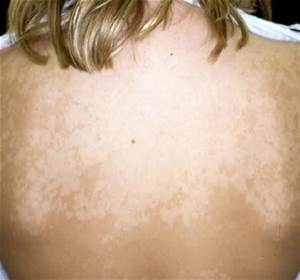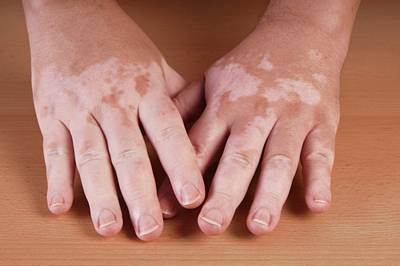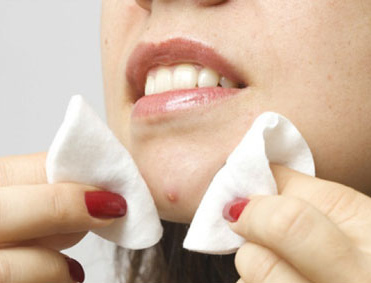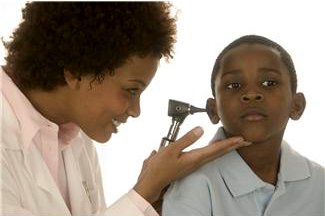Last month we talked about zinc based sunscreen and the importance of using one year round, let alone in the summer sun. This month, I’d like to talk to you about some causes of abnormal skin coloring or skin that doesn’t tan, referred to as “hypopigmentation” in medical jargon. Basically, hypopigmentation is skin that won’t tan, or looks lighter than the rest of your normal skin color. As most people like to have tan skin in the summer, when one or more areas don’t tan, it can be very concerning. Children and teens can have a few different skin disorders that prevent tanning. This article will address a few common causes of hypopigmentation.
Probably the most common cause of white/light spots in kids is a condition called pityriasis alba. While it can appear anywhere on the body, many children develop spots on their face. Pityriasis alba can be seen year round, but it becomes very dramatic in the summer sun. The condition is usually due to dry skin. Children affected likely have a history of eczema or atopic dermatitis. If the skin has been inflamed or is severely dry, the melanocytes (cells that give the skin its color) in that area do not react to UV light the same as they do in non-affected/dry skin areas. The result is light spots.  They may look scaly and will feel rough in texture. Your child may have associated itching in these areas. Treatment is very simple: gentle cleansers and good moisturizers (products like CeraVe work well) applied two or more times daily. Rarely, a prescription for low potency corticosteroid is necessary. Even with treatment, it can take awhile for the melanocytes to get back on track, so evening out of the skin tone may take several months.
They may look scaly and will feel rough in texture. Your child may have associated itching in these areas. Treatment is very simple: gentle cleansers and good moisturizers (products like CeraVe work well) applied two or more times daily. Rarely, a prescription for low potency corticosteroid is necessary. Even with treatment, it can take awhile for the melanocytes to get back on track, so evening out of the skin tone may take several months.
Another common cause of discolored/light spots is tinea versicolor. This rash usually affects teens as well as young adults and is very common in the warmer, more humid months of the year. Facial involvement is rare. Instead, tinea versicolor looks like multiple small (<1 cm), round spots usually on the chest, back, and sometimes the creases of the elbow. It does not itch, although some people complain of itching, and is not contagious. Tinea versicolor is believed to be the result of an overgrowth of yeast known as Malessezia that is considered to be a normal part of our skin’s makeup. The spots may be covered with a very fine scale. They can also be tan or pink/salmon colored. Treatment for this rash will need to be prescription antifungal medications. Topicals and/or orals are necessary depending on the age of the patient and the extent of the rash. Again, even with treatment, complete evening of the skin tone may take several months. Unfortunately, tinea versicolor tends to reoccur frequently.
 Lastly, vitiligo is a more serious medical condition that can cause complete loss of pigmentation. On a fair skinned person, the spots may only be noticeable with a tan, but on someone with ethnic or darker skin, vitiligo can be very distressing. The face is commonly affected as are the hands, elbows, knees and feet. Vitiligo does not cause itch or pain. It is an autoimmune disorder where the body’s immune system attacks the melanocytes, preventing them from producing melanin which is the substance that gives skin its color. Children and adults alike can be affected. There may be other autoimmune processes going on, so an evaluation by a dermatologist is important in determining the diagnosis, evaluating for other symptoms and initiating treatment early to help get the melanocytes working again. It is also very important to use zinc based sunscreen to all of these areas as they have no natural sun protection, and therefore are prone to sunburns and future skin cancers.
Lastly, vitiligo is a more serious medical condition that can cause complete loss of pigmentation. On a fair skinned person, the spots may only be noticeable with a tan, but on someone with ethnic or darker skin, vitiligo can be very distressing. The face is commonly affected as are the hands, elbows, knees and feet. Vitiligo does not cause itch or pain. It is an autoimmune disorder where the body’s immune system attacks the melanocytes, preventing them from producing melanin which is the substance that gives skin its color. Children and adults alike can be affected. There may be other autoimmune processes going on, so an evaluation by a dermatologist is important in determining the diagnosis, evaluating for other symptoms and initiating treatment early to help get the melanocytes working again. It is also very important to use zinc based sunscreen to all of these areas as they have no natural sun protection, and therefore are prone to sunburns and future skin cancers.
If you notice light spots on you or your child’s skin this summer, make sure to call and schedule an evaluation with your dermatologist. The reasons for hypopigmentation can be varied and some may be serious, so a medical evaluation is always a good idea. A dermatologist is experienced in evaluating and treating pigment disorders and is the best place to go to ensure the correct diagnosis, evaluation and treatment.





